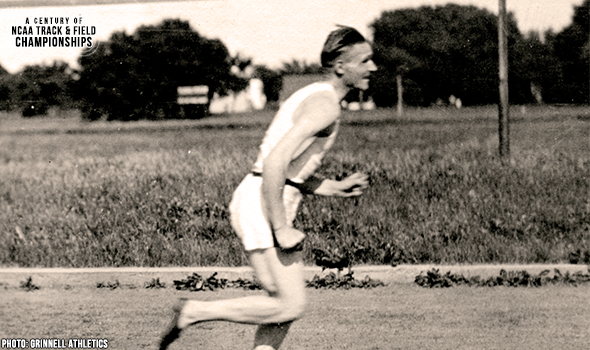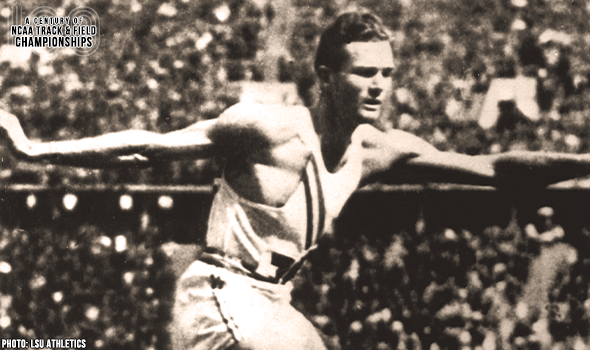
Hurdling History For Forrest “Spec” Towns
Forrest Towns didn’t seem like a record-breaking hurdler when he entered Georgia.
He fell down in his first attempt at the event.
But, two years later, the man known as “Spec” for his freckled face won every hurdles race in sight, including the 1936 NCAA Championships and Berlin Olympics 110-meter hurdles.
His whirlwind year in 1936 saw him run faster than the world record of 14.2 an amazing 10 times. Nine of those were in 14.1, but the fastest came in a post-Olympic race in which he lowered the WR to 13.7 – an improvement by four tenths of a second that remains the largest improvement in event history.
The race was in Oslo, Norway, and Per Avatsmark described the race in Sportsmanden: “From stride one his speed was so great that he virtually flew over the first hurdle. The rest of the race was as perfect as the beginning.”
Towns recalled, “I got off to an unusually good start that day. When I broke the tape I turned around and looked back. The nearest guy was just then clearing the last hurdle. One of the hurdlers came over and banged me on the back and told me I had run a new world record. I asked him, ‘What did I do – run it in 14-flat?’ He said, ‘No, you ran 13.7.’ All I said was, ‘Aw, hell.’”
Towns was well into a winning streak that reached 60 races and lasted through a repeat win at the 1937 NCAA Championships, becoming the event’s first two-time winner.
A month before the NCAA meet Towns was the Bulldogs’ leading scorer at the SEC Outdoor Championships as Georgia won the team title for the first time (It remains the program’s only men’s team title, including indoors). Towns won the 120-yard and 220-yard hurdles and added thirds in the 100 yards and high jump.
Coincidentally, it was high jumping of sorts that got Towns an athletic scholarship. Augusta Chronicle sportswriter Tom Wall witnessed his neighbor’s high school boy jumping over a fishing pole that was placed on the top of the heads of his dad and uncle. It was Towns, and Wall wrote a story about the raw talent that found its way to Weems Baskin, then an assistant coach at Georgia.
Baskin – the 1927 NCAA 120H champ for Auburn – had him try the hurdles. Towns’ wife, Martha, related in a UGA DogBytes story in 2004: “The first time he ran the hurdles on a cinder track he fell and had cinders from his shoulders to his ankles. He got up and asked coach Baskin if he could try it again and coach Baskin said at that moment I knew I had a hurdler.”
Baskin eventually was head coach at Georgia for a year before leaving for longer stints at Ole Miss and South Carolina. His replacement at Georgia in 1939 was Towns, who continued through 1974 – a 36-year period believed to be the longest in SEC track & field history. Towns and Baskin were inducted as part of the 2001 class to the USTFCCCA Coaches Hall of Fame.
Georgia began the Spec Towns Invitational in 1977 and named its outdoor facility Forrest Towns Track in 1990.
The NCAA and collegiate track & field will mark a momentous milestone in the spring of 2021 -- the 100th anniversary of the NCAA Championships and with that, the NCAA Track & Field Championships. In June 1921, the University of Chicago hosted the first track & field championships in NCAA history.
This point can’t be emphasized enough: Not only was the event the first for NCAA track & field, but the first championships for any sport under the sponsorship of the NCAA.
To celebrate, over each of the next 365 days, the U.S. Track & Field and Cross Country Coaches Association (USTFCCCA) will celebrate moments, student-athletes, and coaches that have made a century’s worth of championships special. From humble beginnings to important historical milestones to the modern-day, collegiate track & field has evolved with the American society.
The 2021 edition of the NCAA Division I Outdoor Track & Field Championships begin with preliminary round action on May 27-29 in Jacksonville, Fla., and College Station, Texas. The championships final site and culmination of the celebration is slated for June 9-12, 2021 at the newly rebuilt Hayward Field in Eugene, Ore.

SIU’s Roggy Dominated The Javelin In 1978
Bob Roggy won the javelin title at the 1978 NCAA DI Outdoor T&F Championships by more than 20 feet. Roggy qualified first for the final with a MR heave of 89.30m (293‑0).

Makusha Made History In Bowerman Year Of 2011
Ngoni Makusha became just the fourth man in meet history to win individual titles in both the 100 and LJ. It was his 3rd career LJ crown and he set a CR in the 100 of 9.89.

George Mason’s Gage Shocked The NCAA LJ In 1988
Nena Gage won the long jump at the 1988 NCAA DI Outdoor T&F Championships in a shocking upset over Gail Devers.

Texas’ Thompson Marveled In NCAA Distance Events
Jerry Thompson won three career distance titles at the NCAA Outdoor T&F Championships. His first came in 1943. Then he won again in 1947 & 1948 after serving in World War II.

Grinnell’s Paulu Sprinted To NCAA History
Leonard Paulu was the first athlete to complete the 100-200 double in NCAA Outdoor Track & Field Championships history in 1922. That also made him the 1st to win back-to-back 100 titles, too.

Scott Won Back-To-Back NCAA Hammer Titles
Candice Scott won back-to-back hammer throw titles at the NCAA DI Outdoor T&F Championships in 2003 & 2004. Scott set a meet record of 69.77m (228-11) in that first year.

Drouin Soared To The Bowerman In 2013
Derek Drouin won two career HJ titles at the NCAA DI Outdoor T&F Championships. When Drouin won in 2013, he was only the fourth man to clear 2.34m (7-8) in meet history.

Watts Made Quick Work Of NCAA 400
Quincy Watts set a meet record in the 400 of 44.00 at the 1992 NCAA DI Outdoor Track & Field Championships. It lasted 25 years until 2017.

Iowa State’s Koll Rolled To 5K-10K Crowns
Lisa Koll won three career titles at the NCAA DI Outdoor T&F Championships in dominant fashion. Her average margin of victory in those 5K & 10K races was 37.73 seconds.

LSU’s Hardin Completed Unique 440-220H Double Twice
The nearly unheard of 440-220H double was so nice that Glenn Hardin did it twice! Hardin became the first to do so in meet history in 1933 and then swept them again in 1934.

